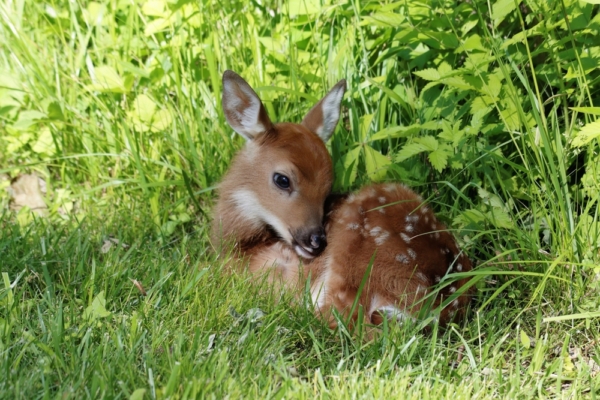A fawn moved into a new home and was hand-reared by animal rescuers. Now, the fawn, named Milly, has become best friends with two dogs and responds when called by her name.
Milly was rescued just under 24 hours after being born in the wild.
A year ago, a passerby mistook the fawn for being abandoned in the bushes and took her to a veterinarian in Moretonhampstead, Devon, UK. Due to the fawn’s previous human interaction, the vet believed her mother wouldn’t take her back and contacted local animal rescuer Steve Hopper. Mr. Hopper, a former police officer from Devon and Cornwall, has dedicated 40 years to rescuing local wildlife.
With the help of his two German Shepherds, Bear and Fox, the 65-year-old Mr. Hopper hand-reared Milly. The two dogs treated her like family. Milly and the dogs played together as though they were siblings. Mr. Hopper mentioned that when called by name, Milly would come, especially if there was a chocolate biscuit awaiting her.
“Milly is very special,” Mr. Hopper said. “I enjoy daily interactions with her. Firstly, her survival is a remarkable achievement.”
“One of the joys for me is seeing her interact with people, especially with the dogs. She really throws herself into it, which is what makes it interesting to me. It’s unexpected, but she doesn’t care; she just wants to play, and the dogs play along with her.”
“Milly is a member of the family. Since she came into the house, the sheepdogs took a liking to her, and Milly actively plays with them. They often hang out together in the enclosure. Milly grooms them by licking their fur, and the dogs return the favor. Milly also nudges them with her head, while the dogs run around like children. They just love to frolic.”
“Milly is still young, so I’m not sure how long this behavior will last, but she interacts with the dogs and me.”
Mr. Hopper explained that typically, fawns learn and mimic behaviors from their mothers. However, because Milly had Mr. Hopper and his dogs as “parents,” she followed their behavior patterns.
Aside from taking care of the fawn, Mr. Hopper tends to three other dogs. Despite introducing Milly to them multiple times, she showed little interest in the additional canines.
Describing how Milly came into his care, Mr. Hopper said, “It wasn’t supposed to happen.”
“When she was found, she was a newborn fawn: still sticky, dirty, with a wet umbilical cord, soft. She had just been born. Usually, when a deer is injured or a fawn is taken away from its mother, they don’t usually survive. On balance, she should have stayed there.”
“The fawn doesn’t move when it’s very young, so it shouldn’t be picked up. But at the time, the vet didn’t have much experience in that area, so they called me. I’ve been dealing with animals my whole life. But this time felt like a crash course for me because it was my first time caring for a baby fawn.”
During Milly’s first 10 weeks under Mr. Hopper’s care, she drank goat’s milk four times a day until her taste buds matured with age, and she began enjoying green foods.
“Pennywell Farm is just down the road, and they were fantastic,” he said. “I called them and said, ‘I have an awkward request, I need your goat’s milk to feed a fawn.’ And they agreed.”
According to Mr. Hopper, different deer require different milk: roe deer and fallow deer can drink goat’s milk but not cow’s milk, while red deer can drink cow’s milk but not goat’s milk.
“Deer don’t wean like humans. Milly started nibbling on grass from a young age. 99% of her nutrient intake was from goat’s milk, but she started nibbling on plants very early on.”
“Then, at around two months old, you start to see a difference: she slowly began to lose interest in the milk, and I noticed subtle changes in her behavior as she looked for something to eat. If there was something green in front of her, she would stop to eat it!”
Now, Milly eats plants, goat’s milk, pellets, carrots, apples, and occasionally chocolate biscuits.
As Milly grew older, she sought less protection from her family. With reduced reliance on Mr. Hopper, she began to show signs of independence.
“Before, she would stick to me like glue because she was so tiny – smaller than a large rabbit – so she naturally clung to me and the dogs,” Mr. Hopper said. “But now, she stays out in the field overnight. I have to send the dogs to find her and bring her back for food.”
“I can call her name; I can whistle as soon as I step outside; or if I haven’t found her yet, she just gravitates towards me like a magnet. But once she knows you’re nearby, she’ll ignore you. When she knows you have something tasty, like a chocolate hobnob or dog treats, she’ll come over. Occasionally, on a nice day, she’ll come over affectionately, gently nudging and accompanying you.”
Because of Milly’s unique upbringing, she won’t be released into the wild but will stay at her new home in Devon.
Mr. Hopper advises dog walkers to keep their dogs on a leash around wildlife. He urges people to use common sense when approaching isolated fawns or injured animals.
Having run his own falconry business, Mr. Hopper says he receives animal rescue calls regularly, all out of his own pocket.
“For any animal or bird, my advice is, if you find one, don’t touch it,” he said. “If you have children, think about it – would you let your two-year-old run around alone in a park?”
“It’s about weighing up the pros and cons, understanding exactly what situation you’re facing.”
By clicking on this Facebook link, you can learn more about Mr. Hopper’s work and follow Milly’s latest developments.

